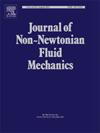A new finite element formulation unifying fluid-structure and fluid-fluid interaction problems
IF 2.8
2区 工程技术
Q2 MECHANICS
引用次数: 0
Abstract
When the accurate simulation of two materials that interact through their common and deformable interface is of interest, the efficient treatment of the interface determines the success or failure of a numerical method. In this work, we propose a new, robust and easy-to-code finite element formulation for such interaction problems. The remedy of the interface constraints, namely the continuity of velocities and stresses, is accomplished using a single-node approach and the same continuous basis functions for the velocities in both materials. Given that only Newtonian fluids will be examined, we do not have to introduce basis functions for the stress components. The XFEM method, which enriches locally the continuous basis function of a variable that presents a discontinuity, is employed to tackle the discontinuous behavior of the pressure across the interface. The incorporation of Petrov-Galerkin stabilization schemes enhances further our formulation and allows the usage of equal order interpolants for velocities and pressure. We solve the coupled system of equations in a monolithic manner to alleviate the convergence problems of the segregated approach. The novel aspect of our method is that its ingredients do not differentiate based on the constituent materials of the problem, and it can be used interchangeably for either a fluid-structure or a fluid-fluid interaction problem. The accuracy of the new finite element formulation is assessed by comparing its numerical results to those of the literature in three problems: i) the flow through a partially collapsible channel, ii) the induced motion of a flexible elastic plate, iii) the filament stretching of a Newtonian thread surrounded by another immiscible viscous fluid. In all cases, we are in agreement with the results of the literature. Furthermore, we conduct a challenging, 3D simulation for a setup that resembles the motion of a three-leaflet stented aortic heart valve.
一种统一流固耦合和流固耦合问题的有限元新公式
当两种材料通过其共同和可变形界面相互作用的精确模拟是感兴趣的,界面的有效处理决定了数值方法的成功或失败。在这项工作中,我们提出了一种新的,鲁棒的和易于编码的有限元公式来解决这种相互作用问题。对界面约束的补救,即速度和应力的连续性,使用单节点方法和两种材料中速度的相同连续基函数来完成。由于只考察牛顿流体,我们不必为应力分量引入基函数。采用局部丰富具有不连续特征的变量的连续基函数的XFEM方法来处理跨界面压力的不连续行为。Petrov-Galerkin稳定方案的结合进一步增强了我们的公式,并允许对速度和压力使用等阶插值。我们以整体的方式求解耦合方程组,以减轻分离方法的收敛性问题。我们的方法的新颖之处在于它的成分不会根据问题的组成材料而区分,并且它可以互换用于流体-结构或流体-流体相互作用问题。通过将新有限元公式的数值结果与文献中三个问题的数值结果进行比较,评估了新有限元公式的准确性:i)通过部分可折叠通道的流动,ii)柔性弹性板的诱导运动,iii)被另一种不混相粘性流体包围的牛顿线的细丝拉伸。在所有情况下,我们都同意文献的结果。此外,我们进行了一个具有挑战性的3D模拟设置,类似于三瓣主动脉瓣支架的运动。
本文章由计算机程序翻译,如有差异,请以英文原文为准。
求助全文
约1分钟内获得全文
求助全文
来源期刊
CiteScore
5.00
自引率
19.40%
发文量
109
审稿时长
61 days
期刊介绍:
The Journal of Non-Newtonian Fluid Mechanics publishes research on flowing soft matter systems. Submissions in all areas of flowing complex fluids are welcomed, including polymer melts and solutions, suspensions, colloids, surfactant solutions, biological fluids, gels, liquid crystals and granular materials. Flow problems relevant to microfluidics, lab-on-a-chip, nanofluidics, biological flows, geophysical flows, industrial processes and other applications are of interest.
Subjects considered suitable for the journal include the following (not necessarily in order of importance):
Theoretical, computational and experimental studies of naturally or technologically relevant flow problems where the non-Newtonian nature of the fluid is important in determining the character of the flow. We seek in particular studies that lend mechanistic insight into flow behavior in complex fluids or highlight flow phenomena unique to complex fluids. Examples include
Instabilities, unsteady and turbulent or chaotic flow characteristics in non-Newtonian fluids,
Multiphase flows involving complex fluids,
Problems involving transport phenomena such as heat and mass transfer and mixing, to the extent that the non-Newtonian flow behavior is central to the transport phenomena,
Novel flow situations that suggest the need for further theoretical study,
Practical situations of flow that are in need of systematic theoretical and experimental research. Such issues and developments commonly arise, for example, in the polymer processing, petroleum, pharmaceutical, biomedical and consumer product industries.

 求助内容:
求助内容: 应助结果提醒方式:
应助结果提醒方式:


